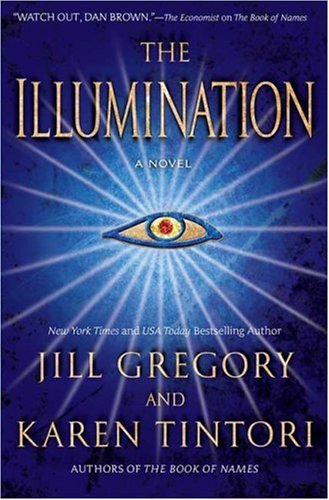
By Karen Tintori (Contributor)
Ethnic literature has, at times, relied on rhetoric imbued with folklore, grandmothers, recipes, and prejudices. That’s not the case here. While grandmothers, ...


By Karen Tintori (Contributor)
Ethnic literature has, at times, relied on rhetoric imbued with folklore, grandmothers, recipes, and prejudices. That’s not the case here. While grandmothers, ...


Featuring Down Under By Karen Tintori
Twenty-eight leading voices in fiction - Including eleven New York Times Bestselling Authors - join together In a celebration of great storytelling. We ...


By Jillian Karr (pseudonym of Karen Tintori and Jill Gregory)
Miss America has vanished and photographer Cat Hansen refuses to sit and wait for someone to find her missing sister. Charging ...


By Karen Tintori
Featuring two accounts by Karen Tintori, this latest book from Casa Italia is an anthology about the Italian American experience as seen through the eyes of women. The first ...


By Karen Tintori and Jill Gregory -- originally published under the pseudonym Jillian Karr
Four glamorous women. Four perfect brides. Four deadly secrets. When Perfect Bride magazine ...


By Jill Gregory and Karen Tintori
David Shepherd knows the names of the thirty-six Righteous Souls, upon whose existence -- the Talmud says -- God keeps the world in existence. Thirty-three of ...


By Jill Gregory and Karen Tintori
Museum curator Natalie Landau fights to learn who murdered her reporter sister in Iraq -- and battles powerful forces pursuing the mysterious gift her sister ...


By Karen Tintori
One of the Chicago Tribune's Favorite Books of 2002, Trapped is the story of the worst coal mine fire in U.S. history, and still stands as that country's third worst coal ...


By Karen Tintori
Unto the Daughters is the story of a secret guarded so fiercely for nine decades that members of Tintori’s family died without ever learning of it. Unto the Daughters ...


By Rabbi E.B. Freedman, Jan Greenberg and Karen A. Katz
Is everything in the Bible true? Why are there bad people in the world? Can't God stop them? Why do I need to learn to read, write, and ...


When state and religion collude to cement masculine power and undermine and control women it makes sense to look to a spiritual age, before patriarchy even existed, where the Goddess held ...
The June 24 Festa di San Giovanni -- the Feast of St. John the Baptist -- is a holiday celebrated by Italians in numerous cities since pre-Medieval Times. In some cities today, the celebration can last two to three days, with markets, and festivities each day. On the evening of June 23 bonfires are lit, nascent green walnuts are gathered from the trees, and the evening dew is collected in barrels and from the grass since it is believed to be imbued with magical powers. Tied to the Summer Solstice, this feast of a Catholic saint retains numerous pagan underpinnings. The bonfires are a reminder of those lit on the shores of Genoa to welcome St. John's relics to the city in 1098. In ancient days, the harvest of black walnuts while the husk is still tender and green to make a liqueur called Nocino was done by young virgins who climbed the trees, knocking down the nuts and then spreading them across the fields to absorb the evening's magic dew. Quartered the next day, then infused in a bath of alcohol and spices for six months, the green nuts produce a wonderful, rich, dark liqueur. Luckily for me, my son and daughter-in-law have a huge walnut tree in their front yard, and I get to make Nocino from the nuts my grandtwins collect for "Nonnie."
Pagan practices and Catholic traditions meld in this holiday. The night of the 23rd, also tied to the Divine Feminine, is an auspicious night for healers. The water collected from the dew is symbolic of St. John's baptismal waters. The streghe -- the healers, the white witches -- would collect the potent evening dew, adding herbs and other ingredients to make new batches of potions and ointments, leaving these mixtures outside overnight to soak up the energy of the moon. Some of this precious water was infused with flower petals overnight in the belief that washing one's face with the mixture on the morning of the 24th brought good luck and renewed beauty and protection from malocchio -- the evil eye.
Italian proverbs say that anything can happen and everything can be remedied on this night, especially love. St. John's Eve was a time for divination of love by young men and women, who would drop molten lead into cold water and then interpret the hardened shapes left behind. In the alternative, should no lead be available, and you'd like to try this for yourself, you could separate an egg white from its yolk, drop it into a glass of water and leave it on your windowsill overnight on June 23. Bubbles floating at the top the next morning are a sign that you will find a mate who is comely, wealthy and simpatico, or "nice." An image of a church is a good omen, but not one indicating you will get married within the year. No images in the water? Better luck next St. John's Eve.
I love the way the Italians have incorporated the pagan and the Catholic rituals to make unique rituals all their own, and have featured some in my other novels, including the traditional method for determining whether someone has been cursed with the evil eye. The Festa di San Giovanni and the search for the Divine Feminine play a crucial role in my work in progress, a novel titled now as The Goddess of Eden. Anything and everything does happen on this auspicious evening to my protagonist, Lia, as the festival bonfires trigger her to relive a childhood tragedy that changed the trajectory of her life.